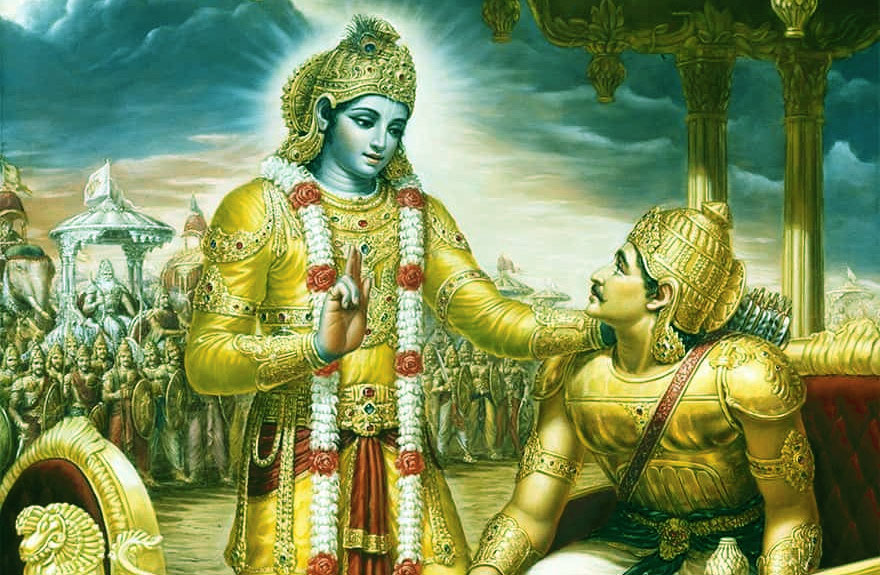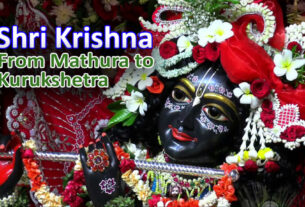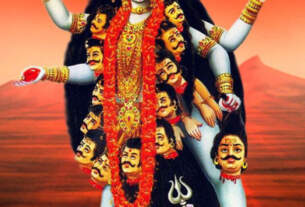By Bhalakatha Team
The Bhagavad Gita, often referred to as the Gita, is a sacred and profound text that holds a central place in Hindu philosophy and spirituality. It is a part of the larger Indian epic, the Mahabharata, which is a narrative of the great Kurukshetra War. The Bhagavad Gita is a dialogue between the warrior prince Arjuna and Lord Krishna, who serves as his charioteer and spiritual guide. This timeless conversation takes place on the battlefield of Kurukshetra, where two factions of a royal family, the Kauravas and the Pandavas, are poised to engage in a cataclysmic war.
The Mahabharata, a massive epic poem, is traditionally attributed to the sage Vyasa and is estimated to have been composed over many centuries, culminating around the 4th century BCE. It is a saga of intricate plots, familial conflicts, and moral dilemmas, reflecting the complexities of human nature and the challenges faced in the pursuit of dharma (righteousness). At the heart of this grand narrative lies the Bhagavad Gita, a concise yet profoundly philosophical discourse that captures the essence of the epic’s themes and presents them in a distilled form.
The Bhagavad Gita is set against the backdrop of the Kurukshetra War, a conflict between the Kauravas and the Pandavas, two branches of the Kuru dynasty. The Kauravas, led by the ambitious and power-hungry Duryodhana, unjustly deny the rightful share of the kingdom to the Pandavas, led by the virtuous Yudhishthira. After years of negotiation, the attempts to avert war fail, and both sides prepare for a massive battle on the plains of Kurukshetra.
Amidst the din of conch shells and the marching of armies, Arjuna, a key figure among the Pandavas, experiences a profound moral crisis. He is suddenly overwhelmed by doubt, compassion, and a deep sense of ethical dilemma as he faces the prospect of fighting against his own kin, revered elders, and beloved friends present on the opposing side. It is at this pivotal moment that Arjuna turns to his charioteer, Lord Krishna, for guidance.
Krishna, who is not only a charioteer but also an incarnation of the divine, responds to Arjuna’s inner turmoil with compassion and wisdom. He imparts profound teachings that encompass a wide array of subjects, including duty (dharma), righteousness, spirituality, karma (action and its consequences), devotion, and the nature of reality. These teachings collectively form the essence of the Bhagavad Gita.
The Gita’s teachings are presented in the form of a dialogue between Arjuna and Krishna. As the conversation unfolds, Krishna reveals to Arjuna the nature of the self, the universe, and the ultimate purpose of life. He explains that the body is temporary and that the soul is eternal, beyond birth and death. Krishna emphasizes the importance of performing one’s duty without attachment to the results, a concept known as karma yoga. He introduces the concept of bhakti, or devotion, as a means to attain spiritual liberation.
Furthermore, Krishna expounds on the various paths to spiritual realization, including the paths of knowledge (jnana yoga) and meditation (dhyana yoga). He elucidates the idea of the divine order (dharma) and how one’s actions, when aligned with righteous principles, contribute to the well-being of society and the individual.
The Bhagavad Gita is a profound philosophical discourse that transcends time and culture. Its teachings provide insights into the complexities of human existence and offer guidance on how to navigate the challenges of life with wisdom and grace. The dialogue between Arjuna and Krishna serves as a spiritual compass, guiding individuals on their quest for self-discovery and liberation.
The Gita’s influence extends far beyond the boundaries of Hinduism. Its universal themes and profound insights have captured the hearts and minds of people from diverse backgrounds and belief systems. Throughout history, scholars, philosophers, and spiritual seekers from various traditions have been drawn to the Gita’s teachings, finding in them a source of inspiration and guidance.
In conclusion, the Bhagavad Gita’s background is intricately woven into the tapestry of the Mahabharata, an epic saga of dynastic struggles, moral dilemmas, and cosmic principles. Set on the battlefield of Kurukshetra, the Gita presents a timeless dialogue between Arjuna and Krishna, encompassing a wide range of philosophical and spiritual subjects. Its teachings provide profound insights into the nature of reality, duty, and the path to self-realization. As a philosophical gem of the world’s spiritual heritage, the Bhagavad Gita continues to illuminate the path of seekers on their journey towards self-discovery and spiritual enlightenment..
bhalakatha
prayas
mind plugin
#bhalakatha #prayas #MindPlugin





